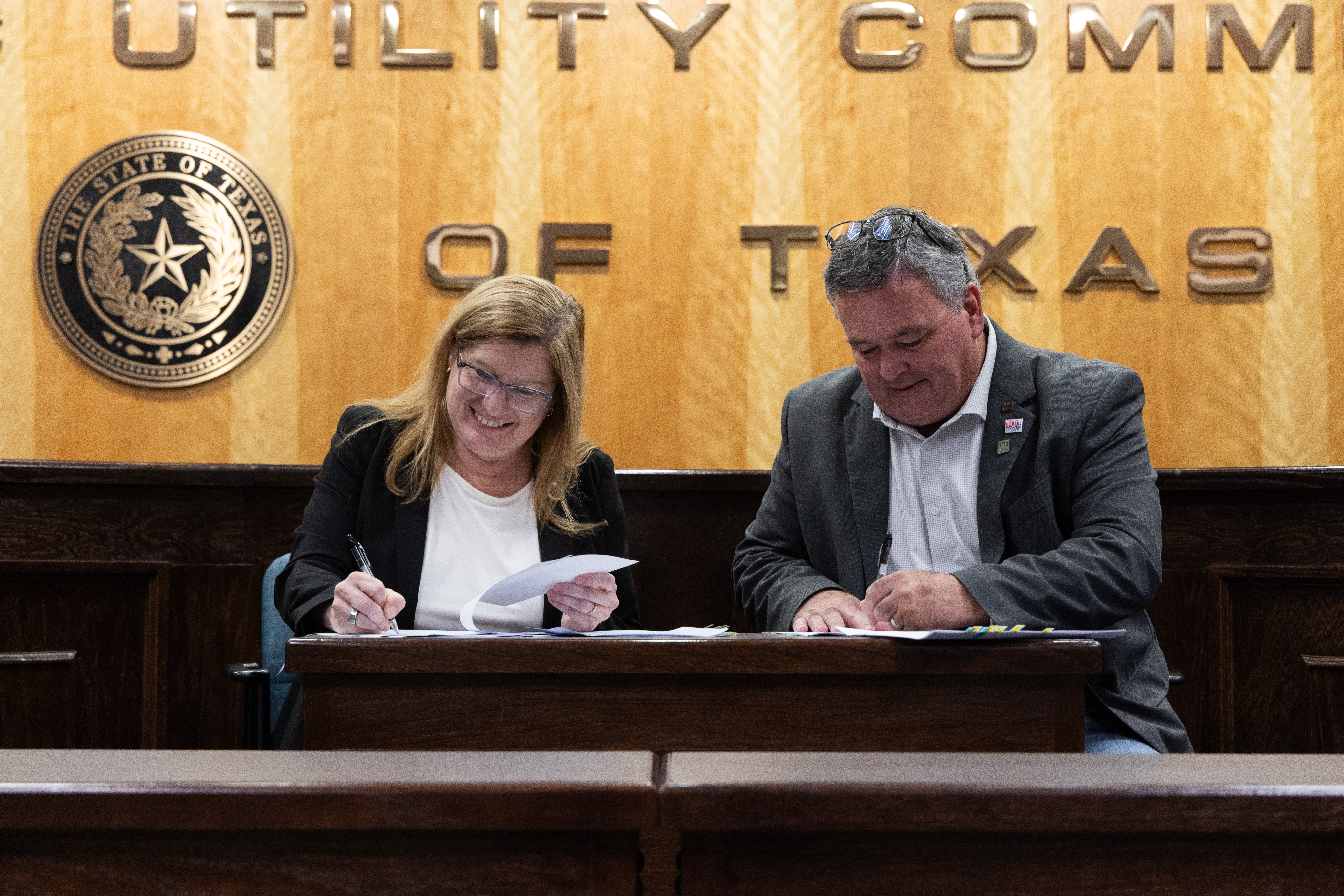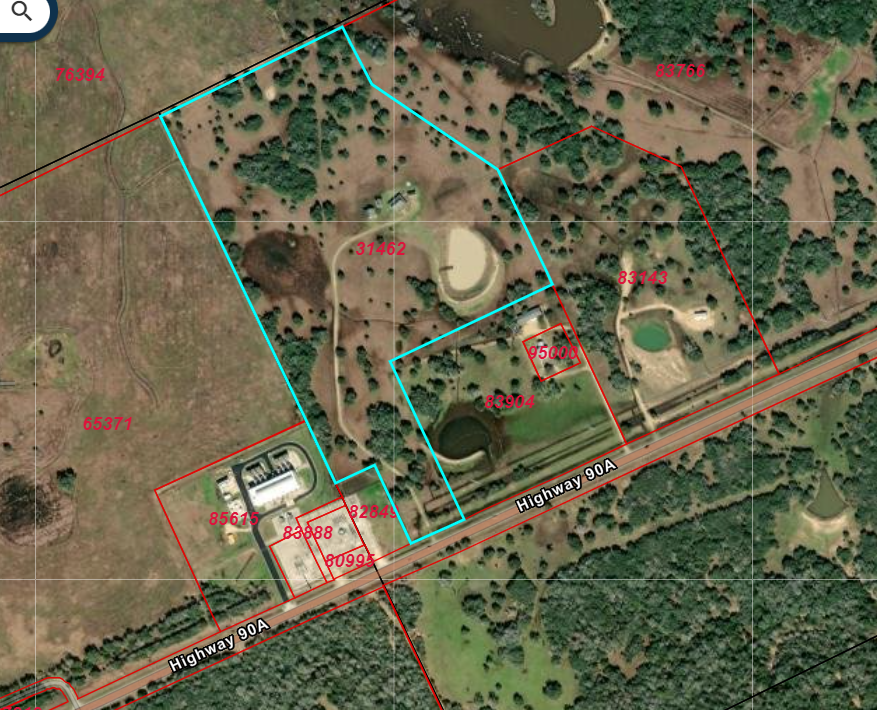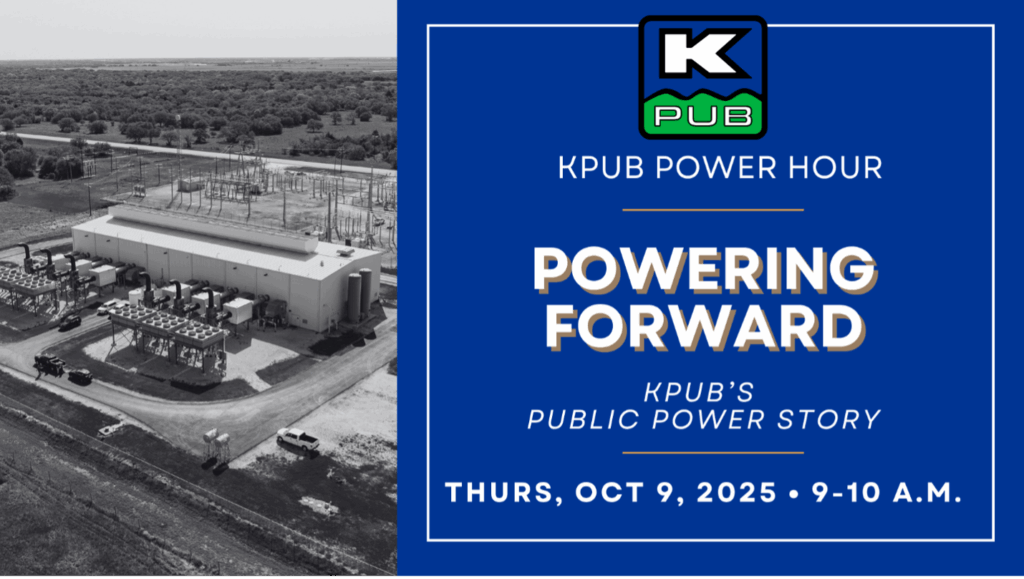Power Generation Project

Kerrville Public Utility Board’s (KPUB) mission is to be a responsive and efficient, locally-owned provider of safe and reliable utility service at the lowest responsible price.
KPUB’s rates are designed to recover the cost of serving each customer class. We purchase power for our customers from diverse, competitive sources to ensure the best rates possible. KPUB powers our customers’ homes and businesses with some of the lowest electricity rates in Texas and across the entire U.S.
KPUB has a power supply contract that is ending in the next few years, which supplies a large portion of our current power supply portfolio. Our utility is currently moving forward with the development of a KPUB owned generation project. This strategic move has been a long-term consideration for the electric utility company for several decades.
With the energy market growing increasingly volatile, we believe that owning our own generation resources will place KPUB in a stronger position to continue to maintain stable rates for our customers for decades to come.
KPUB is a public power utility company, and our board and leadership team make decisions with the best interests of our customers and community in mind. We highly value your input and time because this organization is community-owned—we are your KPUB, and your power.
How Our Project is
Powering Forward
Public Presentations
In addition to hosting more than 20 presentations for local community groups, KPUB also held two Power Hour events to engage with our customers on this important topic in August 2024. Both events were held in the KPUB Boardroom.
If you were unable to attend, the presentation was recorded and is available for public viewing.
Additionally, if you are part of a local civic organization and would like to have KPUB give a presentation at an upcoming meeting, please click here to email us.
Upcoming Power Generation Presentation
In honor of Public Power Week, join KPUB for a special Power Hour presentation on Thursday, October 9, 2025, in the KPUB Board Room, from 9-10 a.m., with Q&A to follow.
This session provides an opportunity to learn more about what makes KPUB unique as your community-owned, not-for-profit electric utility, and how our business model directly benefits our customers.
We’ll explore KPUB’s storied history, how we’ve grown and served the Hill Country since 1987, and how we’re writing the next chapter in our history book—by stepping into power generation ownership for the first time.
Come discover how we’re powering forward—together.
RSVP is required. Please RSVP to [email protected]. Coffee and refreshments will be provided.
If you have a project question that’s not covered in this Q&A, please click here to email us for consideration to have your question added!
Q&A for the project
Why is KPUB investing in owning its own power generation?
KPUB has a power supply contract that is ending in the next few years, which supplies a large portion of our current power supply portfolio.
Our utility is in the historic process of now owning our own generation. This strategic move has been a long-term consideration for the electric utility company for several decades.
The energy market has become increasingly volatile with market scarcity and rising power demand and extreme weather events.
This project strengthens KPUB’s ability to protect our ratepayers and continue offering some of the lowest electric rates in Texas for decades to come.
What generation technology and fuel will be used at this facility?
This will be a natural gas-fired reciprocating internal combustion engine (RICE) generation plant. This type of plant is dispatchable, meaning it can be turned on anytime and is not dependent on a source like the wind or sun. RICE plants are highly efficient and can continue operating at full capacity during extremely hot or cold weather.
RICE generation plants are equipped with a closed-loop cooling system with water-to-air radiators, which means water consumption is almost zero.
Where will this power generation facility be located?
The facility will be located in Colorado County, approximately 10 miles south of Columbus, Texas. The site was selected for its excellent infrastructure and proximity to four major natural gas pipelines.
Importantly, the plant will be built next door to an existing generation facility—Sky Global Power One—which is built, owned, and operated by Sky Global Partners. This proven site allows KPUB to leverage existing infrastructure and local expertise while ensuring a highly reliable and efficient operational environment.
Aerial view of KPUB’s future power plant site in Colorado County, which neighbors Sky Global Power One

What is the timeline for this project?
Construction of KPUB’s new natural gas-fired generation facility is anticipated to begin this winter (as early as December 2025), with commercial operations targeted for June 2027.
How much power will this facility generate?
Texas Energy Fund (TEF) project recipients are required to add at least 100 MW of new dispatchable generation capacity to the ERCOT grid. The new KPUB power generation facility will have the capacity to generate up to 122 megawatts (MW) at peak output.
What is the project cost and how is it funded?
The Kerrville City Council unanimously approved KPUB’s financing plan for a 122 MW power generation facility with an estimated project cost of up to $175 million.
The facility will be funded with a low-interest loan from the Texas Energy Fund (TEF) covering approximately 60% of the project cost, with the remaining 40% financed through tax-exempt revenue bonds. On June 26, 2025, KPUB became the first generation project—and the only municipally owned utility—to execute a loan agreement with the Texas Energy Fund through its In-ERCOT Generation Loan Program. In addition, KPUB has applied for funding through the TEF’s Completion Bonus Grant Program.
It is important to note that this facility will replace a power supply contract that has averaged almost $21 million annually over the last four years. Given the increasing load and market scarcity in ERCOT, the cost of power supply contracts is expected to rise significantly. This investment will better position KPUB to maintain stable and affordable rates for our customers for decades to come.
What is the Texas Energy Fund?
Texans voted to create the Texas Energy Fund (TEF) through a constitutional election on November 7, 2023. The Public Utility Commission of Texas (PUCT) was directed by the Texas Legislature, through Senate Bill 2627, the Powering Texas Forward Act, to administer the TEF programs. The Legislature appropriated $5 billion to fund the TEF for fiscal years 2025 and 2026.
The TEF provides grants and low-interest loans to finance the construction, maintenance, modernization, and operation of electric facilities in Texas. Funding opportunities are available through four programs, based on an application and award process administered by the PUCT.
One of these programs, the In-ERCOT Generation Loan Program, offers low-interest loans to qualifying companies for the construction of new dispatchable electric generating facilities within the ERCOT region, or for the expansion of existing facilities. To qualify, projects must add at least 100 MW of new dispatchable generation capacity to the ERCOT grid.
Will tariff costs impact the plant budget?
While the impact of tariffs on KPUB’s power plant project remains uncertain due to evolving market and policy conditions, we are well-positioned to manage any potential tariff-related cost increases.
A contingency is already built into the project’s overall $175 million budget specifically to cover unforeseen expenses, including possible tariff-related costs.
What is the rate impact for this project?
KPUB already has some of the lowest rates in our region, Texas, and even the United States. This project should help us ensure that our rates remain competitive.
KPUB has worked with multiple external experts to develop financial modeling for this project. Acknowledging that the energy market is volatile and unpredictable, our modeling consistently shows that this project supports rates that are lower than the alternative of continuing to purchase power from wholesale suppliers.
How will KPUB address natural gas price volatility concerns?
Natural gas sets the price of electricity in the ERCOT market whenever the load on the grid is moderate or high (when the grid’s load is low, renewables tend to set the price, and those prices tend to be low). This means that no matter what we do, our cost of electricity will be heavily influenced by natural gas prices.
Because of this, KPUB already has a natural gas hedging program that helps moderate our electricity costs. A similar, but updated program, will be needed for a power generation plant. We have begun working on the new program and will have it fully implemented when the plant is operational.
What are the benefits of this project?
While this power generation project would not remove us from the ERCOT market, in combination with a revised hedging program, it would provide our customers with additional—but not complete—financial protection from volatile market rate prices during extreme weather events, such as the February 2021 Winter Storm Uri. This project will better position KPUB to maintain stable rates for decades to come.
It also supports Texas’ plan to improve grid reliability by adding new dispatchable power generation to the market. Given that ERCOT is forecasting energy demand to nearly double between 2024 and 2030, this project supports Texas’ plan to improve grid reliability by adding new dispatchable power generation to the market.
Additionally, this project allows KPUB to offer more innovative service offerings to our customers through advanced technology.
Is this generation technology and equipment reliable?
Yes—KPUB’s planned generation technology is highly reliable and proven in real-world conditions. The facility will feature 122 megawatts of dispatchable generation, powered by six natural gas-fired reciprocating internal combustion engines (RICE). These advanced engines are designed for fast-start capability, high efficiency, and consistent performance across a wide range of operating conditions.
As a benchmark of reliability, the plant will be located next door to Sky Global Power One, a 50-megawatt RICE facility developed by Sky Global to serve San Bernard Electric Cooperative. That facility has become a model for operational excellence. During Winter Storm Uri in 2021, when many generation plants across Texas went offline due to freezing conditions or fuel shortages, Sky Global Power One achieved 99.6% availability.
Building on that success, KPUB’s facility will use larger, more advanced engines from a different manufacturer, offering increased capacity and improved performance while benefiting from the proven reliability of this technology type.
Who are the project partners for KPUB’s generation facility?
KPUB has assembled a highly experienced team for this project:
-
Leading the effort is Sky Global Partners, a small and highly experienced power plant developer and operator. They won’t just build our plant — they’ll operate it long-term as KPUB’s generation department. Learn more about Sky Global Partners online here.
-
MAN Energy Solutions, our engine supplier, has been manufacturing engines for over 120 years, and they built the first functioning diesel engine. Learn more about MAN Energy Solutions online here.
-
Summit Industrial Construction, a Texas-based construction firm with deep experience in energy and industrial infrastructure, will serve as the general contractor. Learn more about Summit Industrial Construction online here.
-
Longtime KPUB partner SEnergy will oversee engineering and design, drawing on more than 25 years of experience working with the utility. Learn more about SEnergy online here.
-
Kinder Morgan will provide the natural gas supply under a firm, no-notice agreement. Learn more about Kinger Morgan here.
How will the new generation facility connect to the electric grid?
The facility will interconnect to a recently upgraded South Texas Electric Cooperative (STEC) 138kV transmission line at the STEC Rock Island Substation, which is located immediately adjacent to the project site. STEC has confirmed that all necessary interconnection equipment is available and that the system can be operational by January 2027.
The transmission line also connects with the Lower Colorado River Authority (LCRA) system within 8 miles, enhancing grid reliability and flexibility.
How does the power get to Kerrville?
While the new power plant will be located in Colorado County, the electricity it generates will be delivered to the Texas power grid—managed by ERCOT. Once on the grid, it becomes part of the statewide pool of electricity that KPUB and other utilities draw from.
That means the plant’s electrons won’t flow directly into homes in Kerrville, but KPUB will purchase the power generated there specifically for our customers. This is the same model from which we already buy power today—from multiple sources and projects all across Texas.
Will there be additional transmission costs since the plant will not be local?
The power that KPUB buys currently is not generated locally either.
KPUB currently pays and will continue to pay transmission costs, whether we build a plant in Colorado County or continue to buy power from outside suppliers.
KPUB is experienced with managing these costs, including using financial tools available through ERCOT to manage congestion costs on transmission lines.
Does owning generation protect KPUB from ERCOT's Rotating Outages?
KPUB will still be mandated to implement load-shedding procedures (rotating outages for customers) if Texas experiences power supply issues during periods of high demand. ERCOT manages the flow of electric power to over 26 million Texas customers (90% of Texans), including KPUB customers, and is responsible for ensuring the supply of electricity is enough to meet customer demand (load). When the electric supply provided by all power generation is not enough, ERCOT begins emergency operations. During an energy emergency, the demand for power must be decreased to avoid uncontrolled blackouts.
If ERCOT goes into emergency operations due to a lack of power supply, all electric utilities in the ERCOT market are obligated to immediately implement load shed procedures when directed by ERCOT.
While this project would not take us out of the ERCOT market, it will provide our customers with financial protection during Winter Storm Uri-type events on the rate side. It also supports Texas’ plan to improve grid reliability by adding new natural gas-fired power generation to the market.
How often will the plant be run, and would there be excess generation?
Unlike generation within a vertically integrated utility, this plant will not run continuously or strictly follow load. Instead, it will stand down when real-time market prices are low—allowing KPUB to take advantage of cheaper market energy—and ramp up only when market prices exceed its marginal cost to operate. While it is technically a “peaker,” its operational profile is more nuanced: it will operate to provide peaking energy or ancillary services in response to market price spikes, not necessarily to follow KPUB’s hourly load shape.
KPUB expects this operating philosophy to mitigate two critical risks. First, this plant offsets the potential for rising power rates by replacing the need to buy power under contracts from third parties at higher and higher costs in a market that is already short of capacity and predicted to be increasingly so in the future. Second, a plant with this technology insulates KPUB’s customers from wholesale power market volatility.
We plan to run the plant when market prices are high, thereby providing power at cost during those times. When market prices are below the plant’s cost to operate, KPUB plans to realize the price advantage by easily turning the plant off and buying power at the low market price. In both cases, we expect the financial benefits of the plant to reduce KPUB’s overall cost to purchase power, thereby facilitating stable rates and cash flows.
The energy needed to serve KPUB’s customers varies greatly depending on the time of day, time of year, weather, etc. This plant produces less than is needed for KPUB’s annual peak, but more than KPUB needs for the vast majority of the year. However, the plant will run based on market price signals from ERCOT rather than based on demand signals from KPUB customers.
Why isn't nuclear being considered?
At this point, our best options are either building a power plant or continuing to purchase power from wholesale providers. When new nuclear plants are built, they will be done using a new technology called small modular reactors (SMR). Unlike traditional nuclear plants that are very large and built on-site, these will be built in a factory and transported to the site where they are needed.
NuScale is a company that was founded in 2007 that’s been leading the effort to develop SMR plants in the United States. NuScale had been working on a power plant for the Utah Associated Municipal Power Systems (UAMPS). The US Nuclear Regulatory Commission approved NuScale’s design in January 2023, but in late 2023, NuScale and UAMPS decided to cancel the project because of rising cost increases (the costs nearly tripled from their original budget).
SMRs are not commercially available in the U.S., and they are simply too expensive at this point. KPUB needs a new power supply source in 2027, so nuclear is not an option at this time. We expect nuclear to be a promising option for KPUB in the mid-to-late 2030s once the technology is commercially available and has been deployed in sufficient quantities to be proven reliable and cost-effective.
Learn more here:
https://www.energy.gov/ne/advanced-small-modular-reactors-smrs
https://en.wikipedia.org/wiki/NuScale_Power
Why isn’t energy storage being considered?
KPUB has explored the viability of installing energy storage. The biggest problem with it is that the systems currently being installed can only provide power for two to four hours. KPUB needs a supply that will be available from dawn to dark on hot summer days and for days at a time during winter events.
Energy storage does an excellent job of helping to integrate renewable sources into the grid, but it is not the right piece for the puzzle we are working on now. It will likely be something for us to consider again in the future.
Why doesn’t KPUB incentivize rooftop solar to increase generation?
KPUB’s focus has been on helping customers educate themselves about energy efficiency improvements before considering solar energy. The idea is to reduce energy usage first and then consider solar if the customer wants to go further. The payback for residential solar is also relatively long.
Our current supply contracts do not incentivize KPUB to reduce load during peak times—this type of savings is what would typically be used to fund a solar rebate program. In the future, we will evaluate the possibility of solar rebate programs, but it is important that rates and costs are fair (a solar rebate program would need to be funded by savings provided by the solar systems and not by other customers).
Why doesn’t KPUB use energy-efficiency, time of use rates or load control programs to reduce the need for this type of plant?
Building the plant will actually put KPUB in a better position to offer these types of programs to interested customers. If we have a power plant providing our power, KPUB will incur spot electricity prices directly and will be able to design programs and time-of-use rates that respond to the spot market.
Our current wholesale power agreements do not provide incentives for KPUB to reduce load during peak energy usage times. We could, of course, negotiate new agreements that do, but even then, those agreements would tend to be shorter term (three to five years), and it would be more difficult to design long-term energy efficiency, load control, and response programs.
These types of programs are good for reducing peak loading, and KPUB looks forward to implementing them in the future.
Even with these types of programs, KPUB will still have a need for a power plant or power supply contract.
What provisions will be made to prevent major plant outages, and what are their costs?
The proposed plant will have six separate engine-generator sets, so this configuration provides high reliability because a failure or breakdown will normally only take 1/6 of the plant out of service. In addition, we will establish a fund to gradually save for large expenditures like major maintenance or replacement power during a plant outage. When the large expenditure occurs, we can pay for it without a significant rate impact by using the funds saved over multiple years.
We expect to be able to build this fund while maintaining stable, competitive rates for our customers.
Will the proposed plant have safeguards in place to prevent cyber attacks?
Yes, there would be safeguards in place to prevent cyber attacks. The North American Electric Reliability Council (NERC) publishes standards to ensure grid security. KPUB already has a regulatory compliance program to meet these standards and the new plant would also be required to meet the standards.
What is KPUB's relationship with the City of Kerrville?
KPUB is a component unit of the City of Kerrville that is overseen by a separate five-member board of trustees. KPUB Board of Trustees members are appointed by the Kerrville City Council and serve without compensation. They are responsible to the City of Kerrville for managing and controlling the system and are empowered with all the city’s authority concerning electricity distribution to consumers.
KPUB was acquired by the City of Kerrville in 1987 to bring the electric utility serving the community back under local control. For 62 years, electric power was generated and sold by companies headquartered outside of Kerr County. In the mid-1980s, the City of Kerrville and LCRA began exploring the possibility of transferring ownership of the system.
At the time, Kerrville had planned to buy the system and designate it as a department of the municipality. After a failed first vote, the Kerrville City Council revised the resolution to have the electric system operated by an independent board and the measure passed.
KPUB was formed after a vote by the citizens of Kerrville and the issuance of $29.5 million in bonds to purchase the system in 1987. This move returned the providership of electric power to the local citizens, bringing the control of the electric system full circle back to Kerrville.
What type of public input has been sought and project information published?
KPUB has conducted extensive public outreach to inform customers and gather feedback on this initiative.
Highlights include:
• A customer power supply survey in summer/fall 2024 with nearly 1,000 responses
• A dedicated project webpage with FAQs
• Social media campaigns, project videos, and numerous press releases
• Coverage in local articles and media outlets, as well as in-person interviews
• Updates in multiple KPUB customer newsletters
• Presentations to Kerrville City Council
• More than 20 presentations to local community groups to gather input and foster transparency
Learn More
KPUB Honored at New York Gala With National Award for Generation Project
December 12, 2025—Kerrville Public Utility Board (KPUB) is proud to announce that its inaugural Public Facility Corporation bond issuance, supporting the construction of KPUB’s new 122-megawatt...
KPUB Becomes First Loan Recipient Under Texas Energy Fund, Celebrates Historic Signing Ceremony
June 26, 2025—The Kerrville Public Utility Board (KPUB), made history this week with the first project to execute a loan agreement under the newly established Texas Energy Fund (TEF),...
KPUB Unveils Power Generation Project Details at Chamber Luncheon
May 15, 2025—The Kerrville Public Utility Board (KPUB) announced new details this week regarding its planned natural gas-fired power generation facility. The update was shared at the...
Kerrville City Council Unanimously Approves KPUB’s Power Generation Plant
March 14, 2025—The Kerrville City Council unanimously approved the funding for the Kerrville Public Utility Board’s (KPUB) proposed natural gas-fired power generation facility this week, marking a...
KPUB Power Generation Project Moves to Kerrville City Council for Approval
March 7, 2025—The Kerrville Public Utility Board (KPUB) has taken a significant step forward in its power generation project, with the KPUB Board of Trustees unanimously approving two key...
KPUB’s Power Generation Plans Continue to Progress Forward
November 20, 2024—At Kerrville Public Utility Board’s (KPUB) monthly November board meeting, its board of trustees passed and approved a monumental resolution for the community-owned electric...

